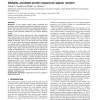Free Online Productivity Tools
i2Speak
i2Symbol
i2OCR
iTex2Img
iWeb2Print
iWeb2Shot
i2Type
iPdf2Split
iPdf2Merge
i2Bopomofo
i2Arabic
i2Style
i2Image
i2PDF
iLatex2Rtf
Sci2ools
69
Voted
BIOINFORMATICS
2010
2010
Globally, unrelated protein sequences appear random
Motivation: To test whether protein folding constraints and secondary structure sequence preferences significantly reduce the space of amino acid words in proteins, we compared the frequencies of four- and five-amino acid word clumps (independent words) in proteins to the frequencies predicted by four random sequence models. Results: While the human proteome has many overrepresented word clumps, these words come from large protein families with biased compositions (e.g. Zn-fingers). In contrast, in a non-redundant sample of Pfam-AB, only 1% of four-amino acid word clumps (4.7% of 5mer words) are 2-fold overrepresented compared with our simplest random model [MC(0)], and 0.1% (4mers) to 0.5% (5mers) are 2-fold overrepresented compared with a window-shuffled random model. Using a false discovery rate q-value analysis, the number of exceptional four- or five-letter words in real proteins is similar to the number found when comparing words from one random model to another. Consensus overr...
Related Content
| Added | 08 Dec 2010 |
| Updated | 08 Dec 2010 |
| Type | Journal |
| Year | 2010 |
| Where | BIOINFORMATICS |
| Authors | Daniel T. Lavelle, William R. Pearson |
Comments (0)

